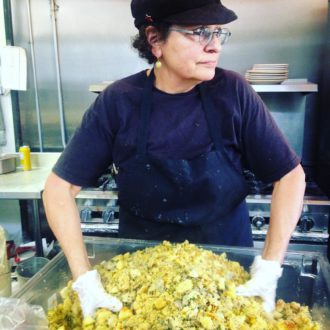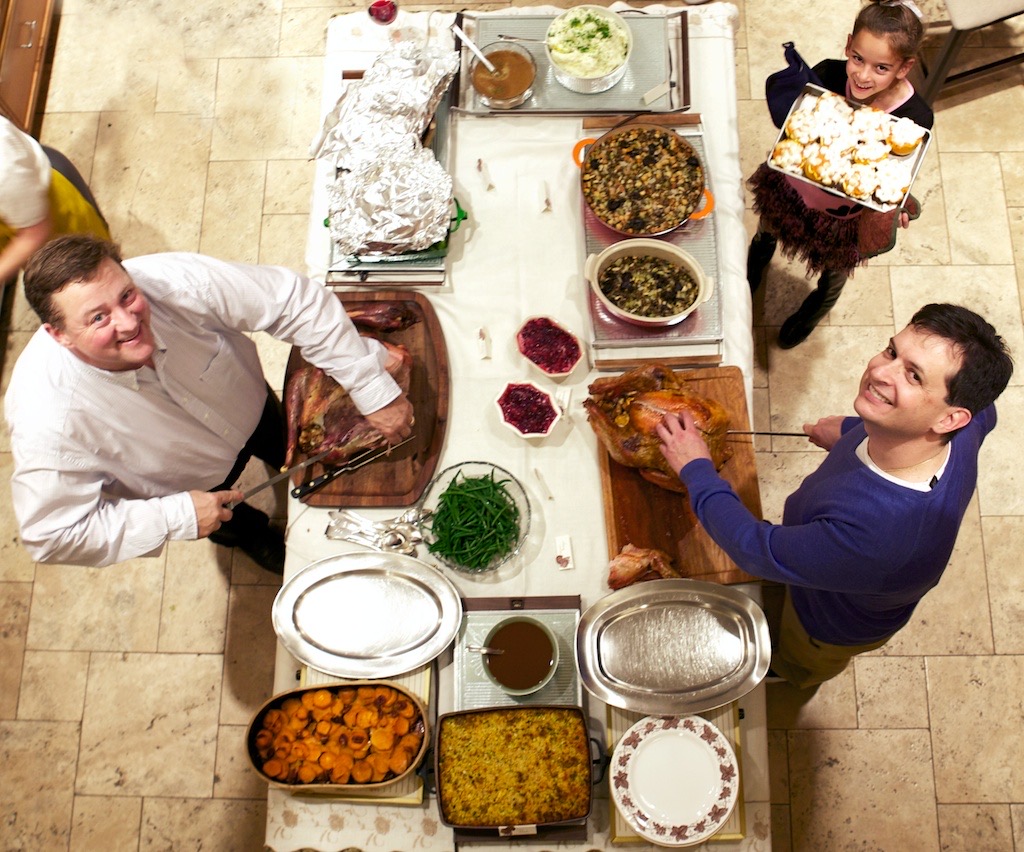Shana McDowell, Western North Carolina native and owner of AVL Cake Lady, needs both hands to count off the dishes served at her family’s Thanksgiving meal, which rotates among locations but is always potluck. “Turkey, ham, cornbread dressing, broccoli casserole, green bean casserole, potato salad, coleslaw, mashed potatoes, rice, gravy, mac and cheese,” she says.
One item that has only rarely made an appearance on this North Carolina table? Bread stuffing. “It has happened,” she admits. “But it’s like, ‘Who brought somebody who brought this?’ I’ve eaten it, but it’s not dressing. I grew up with dressing, and it’s what I know and prefer.”
Dressing, according to McDowell’s frame of reference, is made with cornbread and baked in a pan outside the turkey. Stuffing begins with stale or dried bread — white, wheat, sourdough — and is stuffed inside the bird with extra baked in a pan (though still called stuffing). Both share the basic stuffing/dressing seasonings: celery, onions, herbs and stock.
What people know and prefer when it comes to turkey’s signature side dish depends largely on what side of the Mason-Dixon line they grew up on. Southern Living magazine studied online recipe searches and found that six Southern states accounted for the majority of dressing recipe searches, while stuffing seekers hailed from the North.
North and South
The research is borne out in interviews with members of the local hospitality industry. Grove Park Inn executive chef Richard Gras grew up in upstate New York, where his grandmother cooked the Thanksgiving meal. “It was always a bread-based stuffing,” he recalls “My first exposure to cornbread dressing was my first year on Amelia Island working at the Ritz Carlton. The texture was much different than what I was used to, but the sweetness from the cornbread was good, and I liked it more than what I grew up with.”

Melissa McKnight, Grove Park Inn’s chef de cuisine for banquets, likewise grew up eating stuffing in northwestern Pennsylvania and also had her first exposure to dressing on Amelia Island. “It was an oyster dressing,” she says. “It was shocking, and I was definitely not a fan. I prefer the traditional bread stuffing.”
Between buffets in the Grand Ballroom and Blue Ridge restaurant, a three-course prix fixe dinner in Vue 1913 and more casual fare in the Edison, the Grove Park Inn will serve about 4,500 meals on Thanksgiving Day. Depending on where they eat, diners will have vegetable or sausage herb bread stuffing by McKnight on the buffets, or cornbread pecan dressing by Gras in Vue 1913.
People who prefer to eat at home but aren’t keen on cooking have been placing their orders for a full Thanksgiving dinner with 67 Biltmore Downtown Eatery & Catering since it was Laurey’s Catering & Café at the same address. Former managers and now owners Emily and Adam Thome continue the tradition, leaving the stuffing preparation in the experienced hands of cook Martha Worley. “I grew up in Raleigh, and we ate stuffing,” she says. “We weren’t foodies, and it was easier to use that big old bag of Pepperidge Farm stuffing mix.”
Good stuffing starts with good bread, she notes. “Here, we use all local, quality bread and let it dry out. I’m not going to give away all my secrets, but we use our own stock made from scratch and fresh herbs. It makes all the difference.”
Adam Thome also grew up in North Carolina — and on bread stuffing because his parents were transplanted Northerners. “Stuffing is a long tradition here, and Martha is the stuffing wizard,” he says, noting that the restaurant sends out about 450-500 servings of stuffing each Thanksgiving.
Minus the gluten
Around the time Laurey’s transitioned to 67 Biltmore in 2015, the restaurant began offering a gluten-free cornbread dressing option in response to customer requests. It incorporates vegetable stock and butter, so it’s vegetarian but not vegan. “We sell almost as much of the cornbread dressing as the bread stuffing, and no less of the bread stuffing than before,” Adam says. “Whatever you call it, we have a lot going out from this kitchen.” (67 Biltmore is taking online orders until 6 p.m. Thursday, Nov. 21, for pickup on Wednesday, Nov. 27.)
Requests from customers also drove Kaley Laird, executive pastry chef for Rhubarb, The Rhu and Benne on Eagle, to come up with a gluten-free stuffing. “It is done in a very traditional way — your basics of celery, onions and herbs, chicken stock, a little wine and egg to bind it,” she says. “I wanted it to be a bread stuffing, so we use the gluten-free brioche we make here. There is a significant amount of honey in the brioche, so it’s sweet-savory. I think it’s better than the traditional stuffing we make.”
Mandara Hospitality co-founders Martha and chef Peter Pollay (Posana, Bargello and District 42) have fun with the stuffing-versus-dressing debate that literally divides the island in the kitchen of her family home in Fort Atkinson, Wis., where the couple have been spending Thanksgiving with their large extended family since they married. Both grew up with traditional bread stuffing.
“Bread stuffing with our family (Jones Dairy Farm) sausage is a huge deal in our house,” says Martha. “It is central to the meal. But when I was diagnosed with celiac, Peter came up with a gluten-free cornbread dressing.”
Kitchen wars
Martha’s brother, Philip Jones, is also a professionally trained chef, and at Thanksgiving, he and Peter stage a friendly competition. “We each have our own side of the island,” Peter explains. “He has foraged his own turkey, and it might have a little buckshot in it. I have the beautiful organic turkey. We’re both carving our turkeys. I have the gluten-free turkey, dressing and gravy side, and he has the traditional side with bread stuffing. We both keep an eye to see whose side people go to for seconds.”
While the Pollays are away for the holiday, Bargello executive chef Jordan Arace plans a chestnut and maitake mushroom stuffing for the family-style Thanksgiving meal at the restaurant, gluten included.
To Joe Scully, co-owner/head chef of Corner Kitchen and Chestnut restaurants, it’s all about semantics. “Stuffing is dressing that’s cooked inside the bird, and dressing is stuffing cooked in a pan,” he explains. “I grew up in New Jersey, and we had stuffing. When I moved to Atlanta, it was dressing. To me, it’s the same thing. Some people use regular bread, some people use cornbread, some combine the two. It’s what you add to it that makes a difference. Apples, sausage, mushrooms, walnuts, oysters — all the things that can turn it mouthwatering.”
Though his restaurants will be closed for the holiday, Scully will lead a crew cooking and serving Thanksgiving dinner to about 300 men and women at the Veterans Restoration Quarters. Cornbread dressing is on the menu.
A note on stuffing from the Centers for Disease Control and Prevention: “If you put stuffing in the turkey, do so just before cooking. Use a food thermometer to make sure the stuffing’s center reaches 165°F. Bacteria can survive in stuffing that has not reached 165°F and may then cause food poisoning. Wait for 20 minutes after removing the bird from the oven before removing the stuffing from the turkey’s cavity; this allows it to cook a little more.”




Before you comment
The comments section is here to provide a platform for civil dialogue on the issues we face together as a local community. Xpress is committed to offering this platform for all voices, but when the tone of the discussion gets nasty or strays off topic, we believe many people choose not to participate. Xpress editors are determined to moderate comments to ensure a constructive interchange is maintained. All comments judged not to be in keeping with the spirit of civil discourse will be removed and repeat violators will be banned. See here for our terms of service. Thank you for being part of this effort to promote respectful discussion.